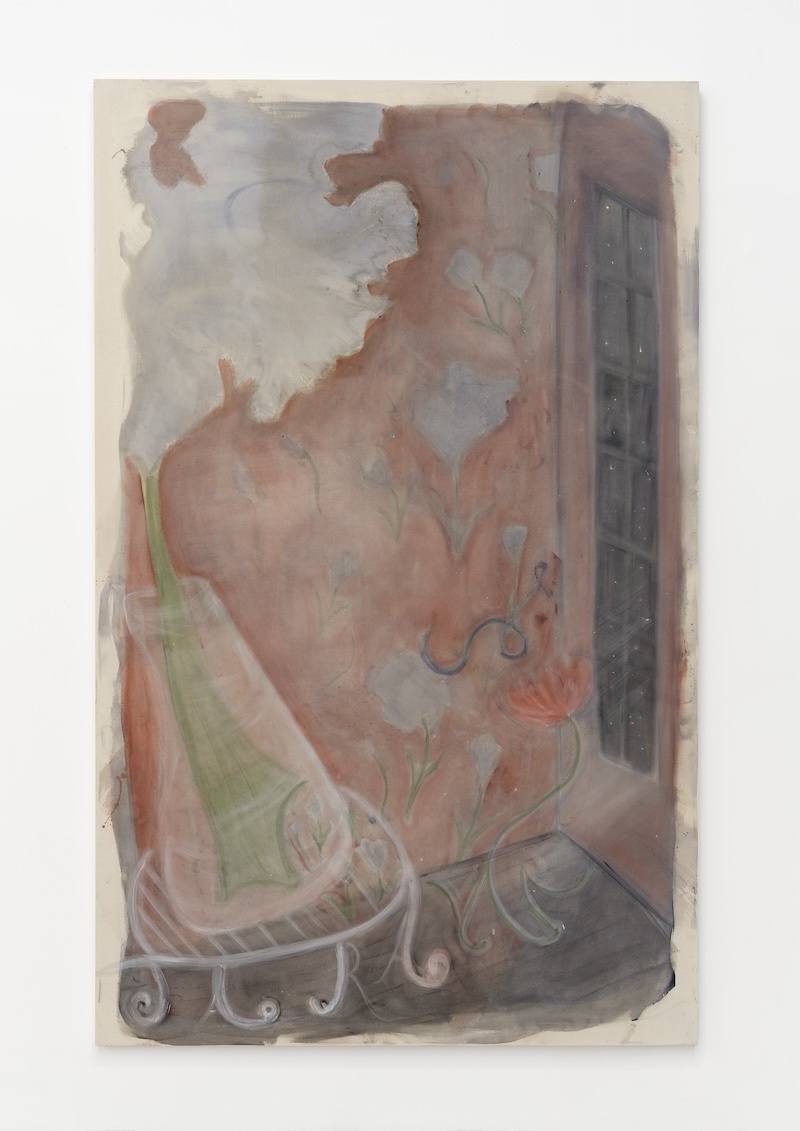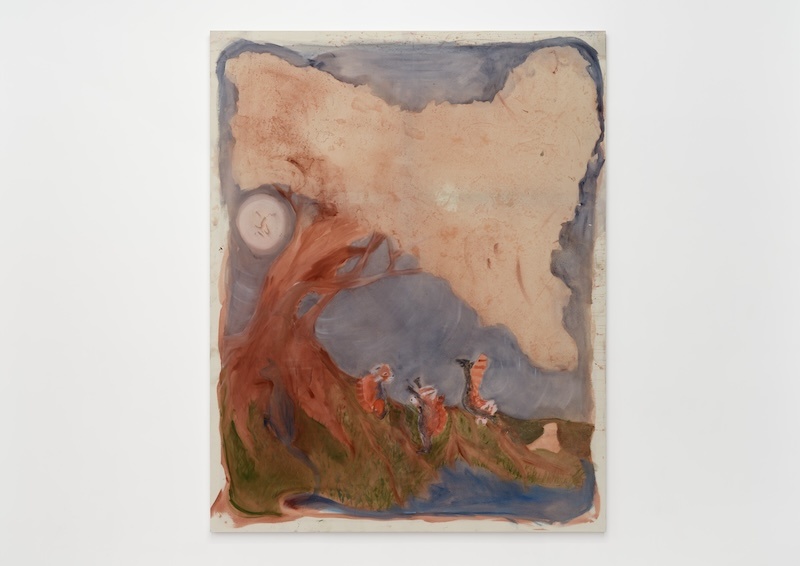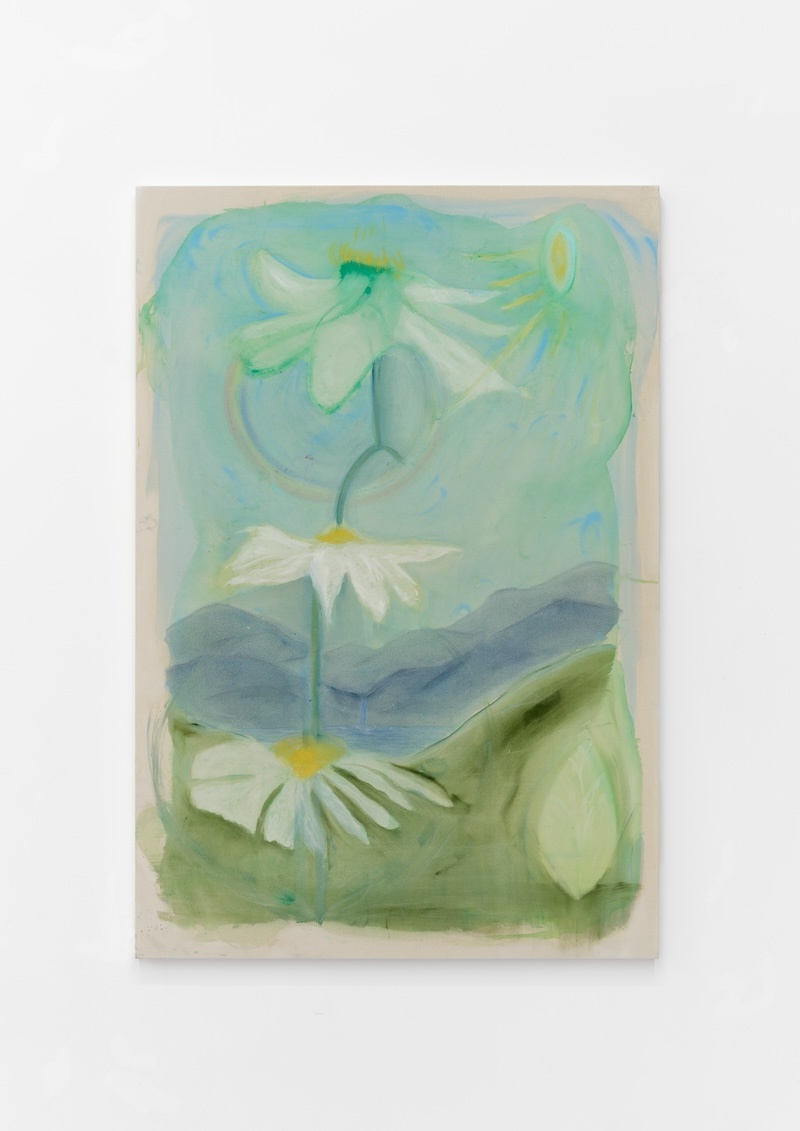On tuning into your intuition
Prelude
Tara Walters (b. 1990, Washington D.C.) currently lives and works in Los Angeles. She received her MFA from the ArtCenter College of Design in Pasadena, CA and her BFA in Painting from the Savannah College of Art and Design in Savannah, GA. Walters’ paintings combine swelling movement and transparency, optical effects that mirror her interest in celestial bodies, prismatic auras, and other sublime and romantic visions. Walters blends paint with the water of the Pacific Ocean. The rebellion of utilizing unprimed canvases allows the softness and gentleness to saturate the canvas and then permeate everyone’s mind, creating surrealistic visions. Her work has been included in solo and group exhibitions in Los Angeles, CA, New York, NY, Shanghai, China, and Venice, Italy.
Conversation
On tuning into your intuition
Visual artist and musician Tara Walters on spirituality, listening to your gut, managing others’ judgements, and evolving your creative practice.
As told to Isabella Miller, 2556 words.
Tags: Art, Magic, Identity, Beginnings, Process, Inspiration.
How did your interest in spirituality develop?
I’ve been into spiritualism since I was eight. I have always been spiritual—my dad’s a music minister and I went to private school my entire life. I have a lot of background in the church, but also my mom was tip-toeing in witchcraft, which I found interesting. I grew up in a very witchy place in Maryland in the woods. It was very ignited.
Then when I was 21, I went on this wild three-month camping excursion to different national parks. I was given a tarot deck from the guy I was traveling with at the time. I learned how to read and was like, “oh my gosh.” And then I started getting all these tarot readings from everybody. From there I was like, “okay, how can I read somebody psychically without having to use a tarot? How can I understand how to drop in and meditate and feel things—to start seeing, hearing, and listening with heightened senses?”
So 2018 comes and I’m in Topanga and my friend Mary [Grisey]’s having this event on a really beautiful patio by the creek. She was giving everybody a reading without using tarot cards. I remember being at this retreat and thinking, “What am I going to do with my paintings?” I was in my second year at ArtCenter, and during the meditations, I suddenly found myself able to visualize deep parts of my mind. In partner practice, I would ask to access someone’s energy and begin seeing detailed aspects of their lives. For instance, with one woman I saw mountains, then I saw the city. I saw two houses. It was all of a sudden and I was just like, “whoa, I’m accessing this part of my brain that I didn’t even know existed, or that I could trust.”
I went back to work and was like, “How can I do this to my paintings? How can I start accessing what the painting wants to be?”

Tara Walters, A Mirror for the Romantic, 2024, water based paint and Pacific Ocean water on Muslin, 118 inches x 55 inches.
Could you elaborate on this moment of revelation? How did you re-approach painting after your experiences with Mary in Topanga?
Now, every time I come into a space, I have to get back to that state of mind where I can channel or listen to the paintings and to see what they really want. I’ll change my clothes or I’ll light some incense. I’ll put some music on and I’ll start heightening the energy in the room.
Did your techniques change as well, or only your more cognitive or imaginative approach to the work?
I started experimenting by applying a layer of color, placing the canvas on the ground, and then lifting it up. This technique creates the first layer, which is why you see paint on the floor of my studio. The painting becomes its own being, and I ask myself: “These are the colors that are there, now what do I see? What do I feel?” I connect deeply with the painting. I visualize shapes and forms, then determine how to express them energetically and accurately. It’s a balance between making additions to the work and preserving the energy.
Did your upbringing spark your curiosity for spirituality?
My mom was very shy as a kid, but she ended up becoming a crazy powerful person, a CFO in the federal government, with a strong feminist viewpoint. I think she loved my dad so much (and they’re still together) because my dad was a Jesus freak. I mean, even to this day, he still works at a church. They both were always questioning ideas about freedom, but also our connection to something that’s greater. My dad was always tapping into something prophetic and was looking at prophets of the past and wondering, “What were they actually doing? How do we demystify it?” This led me to think about how we perceive spiritualists today.

Tara Walters, Looking For Love, 2024, water based paint and Pacific Ocean water on Muslin, 56 inches x 38 inches.
I’ve noticed it’s so easy to be like, “Hilma af Klint, Luchita Hurtado, and Leonora Carrington. These were spiritualists.” But if you think about spiritualists today, I feel like they’re usually dictated as commodifying spiritualism, which to me is the biggest turn-off ever because it’s not about that. It’s about what they were actually doing. She was just having fun, and it’s okay to have fun. Hilma af Klint was having meetups with her friends, and they were talking about what was going on with Rudolf Steiner and Theosophy. Something I felt more in the past, before she had her Guggenheim show, was that you can do things like these, but do not prepare to be taken seriously with it. And she wasn’t. If anything, Steiner called her a fake. And that’s why she was like, “Nobody can see this work for decades.” People were not ready. The world wasn’t ready, and it was funny. Then, everything changed. Now you’re starting to see tarot books in places like the Hauser & Wirth bookstore and even Barnes & Noble.

Tara Walters, Song of Silence, 2024, water based paint and Pacific Ocean water on Muslin, 96 inches x 60 inches.
I’m sure you even see Hilma af Klint books in Barnes & Noble.
Yes. Exactly. You would have never seen that before 2018.
Was your admission to ArtCenter concurrent with the more institutional recognition of spiritualism’s place in art, or did that shift happen afterwards?
I think it happened, weirdly, at the exact same time.
There was a paradigm shift.
Right: I was accepted into ArtCenter early in 2018, around the same time Hilma af Klint’s Guggenheim show opened. This did feel like a significant paradigm shift. I could feel my heart was in the same place hers was. It was incredible to see so many people finally taking her work seriously after so many years.
Earlier, during my undergrad, I got made fun of for being into spiritualism. It’s hard for some people. Then when I would have studio visits at ArtCenter, some people compared my work to other artists who seemed to commodify spiritualism, which felt dismissive to me. It was challenging to be taken seriously.

Tara Walters, Pheonix Queen, 2024, water based paint and Pacific Ocean water on Muslin, 84 inches x 48 inches.
When you were just graduating from school, was it a stressful period? How did you negotiate the desire to make the type of work that you felt was truly important, but also make a living?
When I was in ArtCenter, I was doing a lot of sewing and dyeing, creating fabric-based pieces. But people kept saying, “Why can’t you just make a painting? You just need to make a painting.” My professors would suggest, “Why don’t you simplify all your ideas into a straightforward exhibition?” I understood their perspective because you can’t leap into complex concepts without mastering the basics of creating a solid exhibition with simple paintings. You have to start with the fundamentals.
So, I decided to take it step by step, like progressing through grades in school. Initially, I focused on meditation and channeling my ideas into individual works. This focus resulted in the paintings for my LAXART Thesis Show and my Dropping In show. These exhibitions featured nothing but paintings, with no additional colors or changes to the environment.
Graduating during the pandemic was a challenging time. We couldn’t consider performing or having people attend shows. I graduated in October, and by January, I was offered a solo exhibition in Los Angeles, which was an exciting opportunity amidst the uncertainty.
That happened very quickly.
Very quickly. I didn’t have much time between school and my professional career. Right after graduating, I was picked up by a gallery, which was a rare and lucky break for me. The gallerist took a chance on me, and I was really grateful for that. Now, it feels like both she and I are starting fresh, and I’m thinking about how I can push things forward.
I feel like I’m in a stronger place now, and am thinking about the years I spent playing music in Savannah, Boston, and Nashville. Now, I feel ready to do the next thing, which is the reason why I decided to bring music back into my work.
When I was conceptualizing my show at Antenna Space, my friend, the artist Owen Fu, was like, “You must perform.” I thought, “What are you talking about? I haven’t performed in so long.” I hadn’t practiced, though I occasionally doodled on the guitar. But I got there and was like, “okay, I guess this is going to happen.” Then I got sick, but decided the show must go on.

Tara Walters, Sympathetic Magic, 2024, water based paint and Pacific Ocean water on Muslin, 100 inches x 78 inches.
This experience opened a new door for me. I was like, “Shit, people really love it.” I was hearing things like, “We see the music in your work. We can see the rhythm in your work.” I was surprised—it was the first time people connected my figurative paintings with music. When looking at my work, people were asking, “What do you hear? What does it sound like?”
To me, that’s fascinating. That’s opening up someone’s brain in a way I don’t often see in the art world, especially with figurative painting.
You’ve always had a strong sense of self-trust, even when facing resistance or ridicule in your younger years. Now, you continue to trust your decisions. Could you talk about how you nurtured this trust and how it guides your artistic choices?
We all need to make a living, but it’s possible to do so without selling yourself. You can sustain yourself while actually making a difference and evolving beyond your existing rubric as opposed to continuing something that’s already working. But I mean, I’m not fully trying to break away from established norms; I understand the importance of them. I understand the importance of a good art fair.
I often reflect on the psychologist Eric Erickson’s seven stages of life, especially one of the final stages: generativity. When I’m 80 or 90 years old looking back on my career, am I going to be an artist that just kept on painting, or am I going to be an artist that painted, but also realized the different aspects of my life? So I pushed forward, took a chance, and did it.
This approach is about integrating various forms of expression. For example, combining structured music with painting is something many artists, like Kim Gordon or David Bowie, have found challenging because these art forms often remain separate. Bridging that gap excites me. Seeing just another painting show can feel monotonous.
Staying comfortable with the familiar might work for a while, but eventually, it becomes stale. To create something lasting, you need to continually build and innovate, creating worlds that evolve. This even extends to engaging more Americans in the art world, fostering a deeper interest and appreciation for art.

Tara Walters, Three Flowers Condensing onto its HeadLove, 2024, water based paint and Pacific Ocean water on Muslin, 62 inches x 42 inches.
You have a strong desire to form meaningful bonds and bring people together, rather than having the classic visual art experience of one viewer privately engaging with a work.
That private experience will never go away because galleries are often open with no one in them, allowing for solitary engagement. It’s not about destroying that experience. But it’s interesting—paintings in the 1500s were mainly spiritual, telling stories to people who couldn’t read or write about moral behavior.
It all comes from this spiritual place, this energy that ignites creativity. Even, say, Bob Dylan making a song: There’s something that ignites his soul that could be called a spiritual experience that makes him create something. Then people want to connect with that energy. There’s a saying that when two people are together, a prayer works harder. It’s the same thing when many people come together at a music show or a museum exhibition—there’s an energy shift.
Children’s museums do this successfully, making us think things like, “Oh wow, rainbows are incredible.” How can we maintain that sense of wonder in the often hyper-intellectual and inaccessible art world? How do we break down those barriers so art isn’t just about the hottest artists or high prices? Art shouldn’t be commodified to the point where it feels disconnected and hard to relate to.
For me, it’s about breaking barriers and making art accessible and open to everyone. I see my neighbors and people get upset. They feel like they’re unable to be a part of the art world. And there are parts of the art world that I think are really important, that are secretive. There is a magic sauce that needs to hold its secret recipe. But I think as artists, we are not necessarily owners of that magic sauce. We are the ingredients in the sauce. You know what I mean? Maybe we don’t have the rights to the sauce yet, but we are the stuff that makes the recipe. How can we make it even greater and grander, more fun, more exciting, more inclusive, more of something where people can say, “Oh yeah, we love the art world. Thank you federal government for putting more money towards the arts.” [laughs]
I think that’s how you make it important: Making it more accessible so that maybe America will start thinking more about it in their schools. But I think people need to learn more than just what’s obvious.
Tara Walters recommends:
Travel: Get on a plane, train or automobile and go anywhere. I love spontaneously traveling far away from my every day routine. It’s an instant refresher of feeling like you are everywhere and nowhere at the same time.
Food: (LA only) Sichuan Impression west side location. I always order Mama’s noodles.
Spiritual: Get a psychic reading with Mary Grisey over zoom. She is one of my favorite psychics. I also attend her classes on mediumship studies.
Music: Learn to play “Clair de Lune” on the piano, it is quite cathartic.
Meditate in the Gardens: Go walk around the Huntington Gardens early on a Wednesday when no one is there.. or really any garden that is near and at a time when no one is around and bring a journal to practice automatic writing. It’s a form of meditation.

Tara Walters, Happy New Year, 2024, water based paint and Pacific Ocean water on Muslin, 84 inches x 72 inches.
- Name
- Tara Walters
- Vocation
- visual artist, musician
Some Things
Pagination



